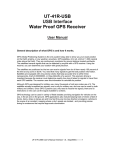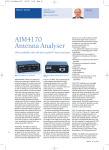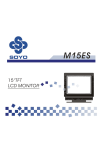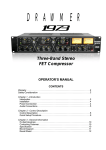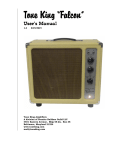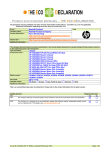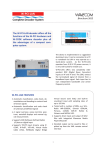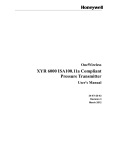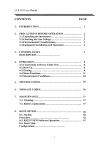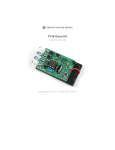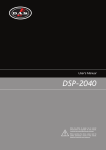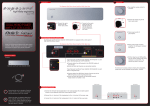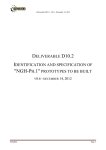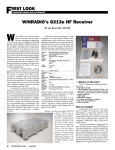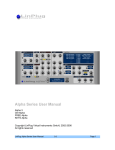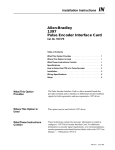Download review
Transcript
Chris Lorek, G4HCL REVIEW PO Box 400, Eastleigh SO53 4ZF. E-mail: [email protected] There is currently a growing number of software-based radios around with ‘black box’ receivers and transceivers using a PC for a virtual front panel control. Chris Lorek reviews the latest offering from the Australian firm of Rosetta Labs: the WiNRADiO WR-G313i. WiNRADiO WR-G313i PC-controlled receiver T he WiNRADiO WR-G313i is a PC plug-in multimode receiver on a PCI card, covering 9kHz to 30MHz with an option of frequency extension to 180MHz. It’s described as a high-performance HF receiver intended for government, military, security, surveillance, broadcast monitoring, industrial and demanding consumer applications. Unlike its cousin the G303, the G313i has its own on-board Digital Signal Processor, which fully performs the final stage IF filtering and audio demodulation and doesn’t rely on the PC sound card for processing. This of course means that you can use the sound card with appropriate software for other applications, like data and SSTV decoding, further DSP processing such as noise reduction, and so-on. Also, if you really want you can of course use multiple G313i receivers in a single PC enclosure. The receiver card simply plugs into any available PCI slot inside your PC, and on the rear is a small SMA antenna socket, together with a 3.5mm audio output socket to feed either amplified speakers or of course your sound card input. The package includes the receiver card, Windowsbased software, a start-up antenna consisting of a terminated coax lead connected to a length of insulated wire, and a user’s manual. CIRCUITRY Up to the demodulator stage, the radio uses a normal dual-conversion The G313i is a plug-in PCI card with an SMA antenna socket and audio output socket provided Fig 1: Block diagram of the WiNRADiO WR-G313i. superheterodyne approach, with an analogue front-end stage followed by a mixer down to a first IF of 45MHz with a synthesiser-derived mixer injection signal. See Fig 1. At the first IF two four-pole 15kHz wide crystal filters are used together with a variable gain amplifier, followed by an analogue mixer down to the second IF of 16kHz nominal (12 – 22kHz variable). Here, the signal is further amplified and AGC (Automatic Gain Control) and S-meter signal levels are derived, before the signal is passed to a 16-bit A/D (Analogue to Digital) converter sampling at 64kHz. From henceforth the DSP (Digital Signal Processor) circuitry steps in to perform the final signal filtering and demodulation, before being passed to a D/A converter to provide the final analogue audio output. MODES & BANDWIDTHS The receiver offers modes of CW, LSB, USB, AM, Synchronous AM, Double Sideband (DSB), Independent Sideband (ISB), and narrowband FM, each with a continuously variable IF bandwidth of between 1Hz and 15kHz Fig 1 Front End • Switchable attenuator • Switchable filters • Preamplifier First IF stage • Crystal filters • Variable gain amplifier + 9kHz to 30MHz (optionally to 180MHz) 45MHz DDS & PLL 45.009 to 75MHz (optionally to 225MHz) audio output DDS & PLL 32.768MHz) 45.016MHz) D/A converter Second IF stage • Amplifier • AGC block • RSSI block 16kHz (variable 12–22kHz) Reference Oscillator DSP PC 36 + A/D converter in 1Hz increments. As well as this there’s a variable bandwidth IF notch filter and a switchable noise blanker with a fully variable threshold setting. There’s a ‘real time’ 20kHz spectrum display with a 16Hz resolution, and a calibrated analoguestyle S-meter display shows the received signal level in S-units, dBm level, or µV, down to the noise floor of around -140dBm. As well as a built-in audio recorder you can also record the 20kHz wide IF spectrum, which lets you then experiment with various playback receive modes and filter widths etc. Together with the real-time analyser the receiver can also display a wide-band spectrum analysis by fast sweeping the receiver across the required range. This also provides peak finding, averaging, display storage and retrieval, as well as a display of minimum and maximum sweeps as well as a differential display (ie one sweep minus another) which is useful to see if any new signals have appeared). Another feature is a test and measurement facility, performing measurements on the received signal including frequency accuracy, amplitude modulation depth, frequency deviation, THD (total harmonic distortion) and SINAD. A real-time audio spectrum analyzer with a 5Hz resolution can also be displayed. You can also explore block diagrams of the demodulator for each mode, and look at the real-time signals at various stages using two spectrum analysers and a vector voltmeter. OPTIONAL PLUG-INS DRM (Digital Radio Mondiale) is a non-proprietary digital system for HF plus medium and long-wave broadcasts, which has the potential of providing almost FM-quality audio. This can be added as a further purchase to the G313i as an XRS (Extensible Radio Specification) plug-in which, after you’ve installed it, is accessible very simply as another mode from the top bar menu. Another optional plug-in is the Advanced Digital Suite, which adds a number of digital processing facilities, including a fax module (for WEFAX and HF fax) with a scheduler, a NAVTEX decoder again with a scheduler, Packet radio decoder, ACARS decoder with a code database, CTCSS and DTMF decoders March 2005 RadCom www.rsgb.org REVIEW with alarms, a signal classifier, an audio scope with waterfall display, a signal conditioner with user-defined filters, and an advanced audio recorder with pitch shift and speed control. Again after you’ve installed the suite, the various modes are accessible from the top bar menu. Finally, if you’d like to control your WiNRADiO from another location, your office for example, the optional WR-G313-CSO client / server lets you do this across all types of computer networks supporting the TCP/IP protocol, including the Internet. With this in use, you can listen to your receiver literally anywhere in the world. ON THE AIR As soon as the card is fitted and you power-up the PC, it’s automatically recognised by Windows and you simply load the driver software which comes on the supplied CD. Then it’s just a case of attaching an antenna (I used an SMA to BNC adapter plus a further BNC to SO-239 adapter here) and an amplified audio source (I used a pair of amplified PC speakers) and tuning in! At first sight the very comprehensive virtual front panel did look rather intimidating. I believe the controls and operating facilities are well in excess of even the most comprehensive ‘top flight’ amateur-class and even professional-class receivers, but I very soon got the hang of using it with the PC mouse. The main tuning dial is controlled by the left / right PC mouse buttons, or I could use the small up / down buttons below the main frequency display. I could enter a frequency directly by using the PC keyboard, and four switchable VFOs can be used to store your last-used frequencies. I found, unlike most amateur transceivers, these did not also store the receive mode and bandwidth etc, but for this there are plenty of memory channels available – up to 1000 in each memory file in fact. Plenty of pre-set IF filter bandwidths were available, and I could also manually enter any bandwidth I wanted and vary this (as with most functions) by using the appropriate small on-screen up / down buttons, or more rapidly by a tiny slider between the buttons. Likewise with the IF shift, but here I could also tune the receiver to another frequency by simply dragging the entire filter passband over a peak of a visible signal on the spectrum display, and ‘drag’ the filter edge to vary it as needed to reduce adjacent interference. The notch filter I found very useful, especially when a heterodyne appeared right in the middle of the signals I was tuned to. Overall I found www.rsgb.org RadCom March 2005 LABORATORY RESULTS Measurement methods: Sensitivity: Input signal level in µV pd to give 12dB SINAD, measured on SSB 2.4kHz bandwidth. Blocking: Increase in level of interfering unmodulated signal, above 12dB SINAD ref level to cause 6dB degradation in 12dB onchannel signal. Image Rejection and Spurious Rejection: Difference in level between unwanted and wanted IF image / spurious signal levels, each giving 12dB SINAD on-channel signals. Selectivity: Single signal bandwidth, measured in kHz. Intermodulation Rejection: Increase over 12dB SINAD level of two interfering signals giving identical 12dB SINAD on-channel third order intermodulation product. MHz 1.8 3.5 7.0 10.1 14.0 18.9 21.0 24.5 28.0 -3dB -6dB -10dB -20dB -40dB -60dB SENSITIVITY Signal Level 0.44µV 0.38µV 0.35µV 0.35µV 0.35µV 0.35µV 0.35µV 0.35µV 0.39µV CW 600Hz 0.61kHz 0.62kHz 0.64kHz 0.66kHz 2.19kHz 5.73kHz MHz 1.8 3.5 7.0 10.1 14.0 18.9 21.0 24.5 28.0 SELECTIVITY SSB 2.4kHz 2.43kHz 2.43kHz 2.45kHz 2.47kHz 4.02kHz 7.47kHz +100kHz 90.5dB 93.7dB 97.8dB 99.2dB 98.1dB 95.7dB 94.8dB 93.2dB 92.3dB AM 6kHz 6.02kHz 6.03kHz 6.04kHz 6.06kHz 7.56kHz 10.63kHz BLOCKING AND IMAGE REJECTION +1MHz +10MHz 1st Image (+90MHz) 91.0dB 100.1dB 81.6dB 94.9dB 102.1dB 80.8dB 101.7dB 103.9dB 79.4dB 103.8dB 102.0dB 64.4dB 102.0dB 103.9dB 64.5dB 102.4dB 101.4dB 66.0dB 102.2dB 101.6dB 66.2dB 101.8dB 102.2dB 66.5dB 102.4dB 101.0dB 65.9dBa INTERMODULATION REJECTION 5kHz spaced signals: 68.8dB 10kHz spaced signals: 73.5dB 20kHz spaced signals: blocking limited 40kHz spaced signals: 82.1dB SPURIOUS REJECTION (Measured with receiver tuned to above 7.3MHz) 11.25MHz: 61.5dB 15.0MHz: 82.1dB somewhat. Likewise close-in blocking and intermodulation was affected by phase noise, but this was arguably no worse than many other receivers. Within the 15 / 20kHz first IF bandwidth filtering the lack of narrower ‘up front’ IF crystal filtering was evident. At greater frequency separations the blocking performance was excellent, in fact pushing the limits of the cavitytuned signal generators I use. There were only a couple of spurious receive responses, at 11.25MHz and 15MHz, which appeared no matter what frequency the receiver was tuned to. the filter and notch slopes to be very steep indeed, a classic ‘brick wall’ response! I did, however, often find strong adjacent signals induced some ‘raspiness’ to the on-channel received signals and often there was also audible ‘clicking’ on fast-rising signals such as strong SSB or CW, probably due to a delay in AGC attack time. But even so, overall the receiver gave a very good account of itself, with certainly at least as good on-air performance of a similarly-priced hardware offering, but with the G313i having vastly more operating features. LAB TESTS My measured results are given in the accompanying table. Of note is the very good IF DSP filtering down to several tens of dB, below this synthesiser phase noise came into effect to widen it Above: The main receiver panel display, showing the selected signal frequency and IF bandwidth. CONCLUSIONS After using and testing the receiver, my overall thoughts were “I’m impressed”. The WR-G313i has a technical performance matching that of conventional receivers in its price class, but with the operational versatility of professional receivers costing £5000 or more. I’m sure it will have many happy and very well satisfied owners. Of note is that the operating software is constantly being updated and is freely available from the WiNRADiO website, giving a considerable degree of ‘future-proofing’ to a purchased receiver – in fact I downloaded an update to improve the operation even more during the review period. Our thanks go to Radixon Ltd in Evesham for the loan of the review equipment. ♦ 37


